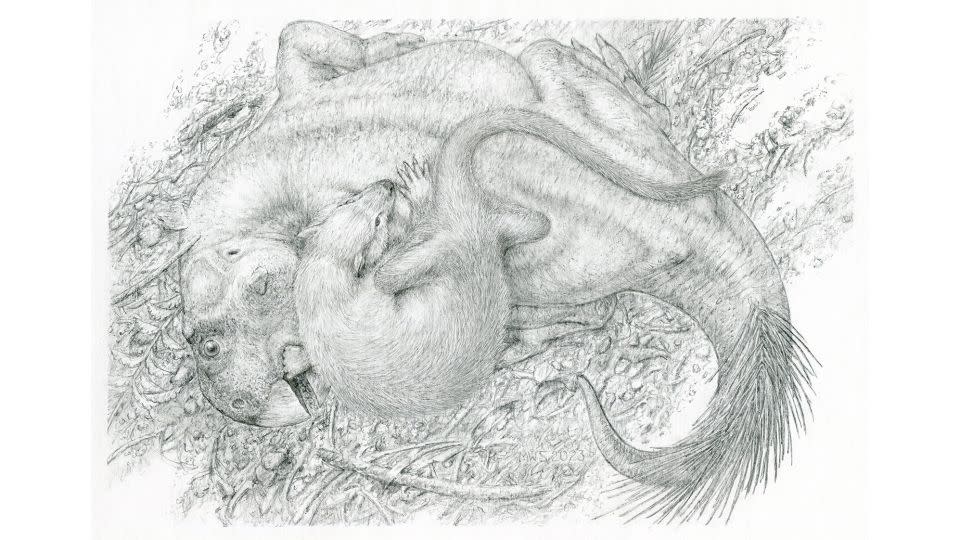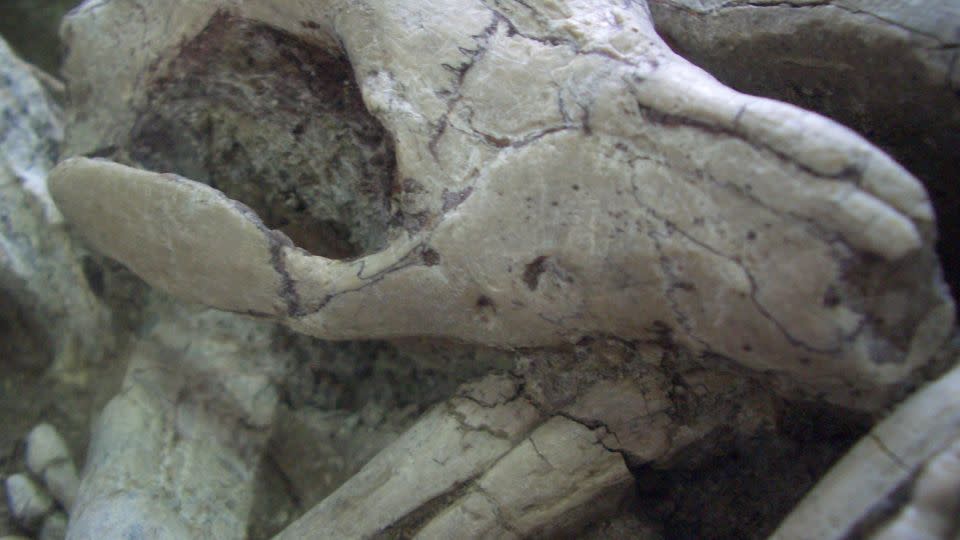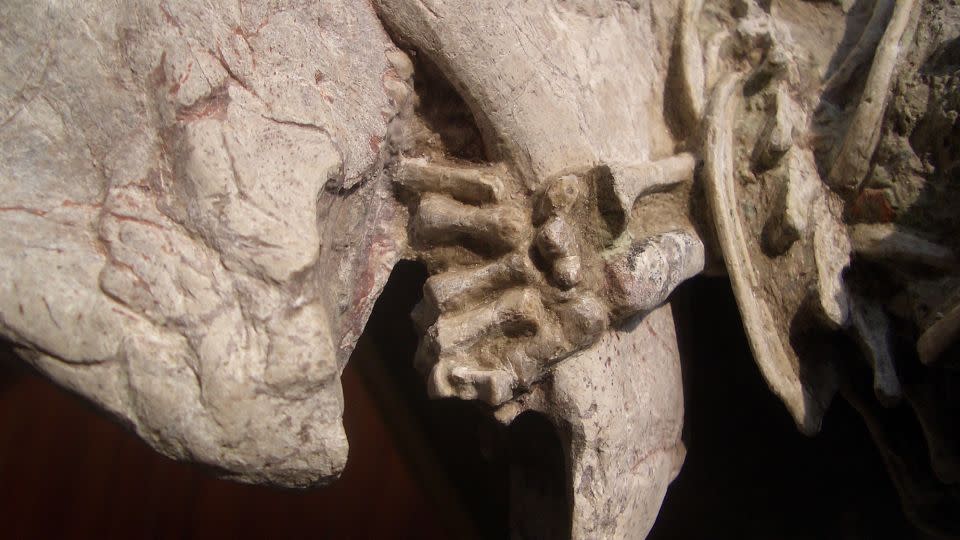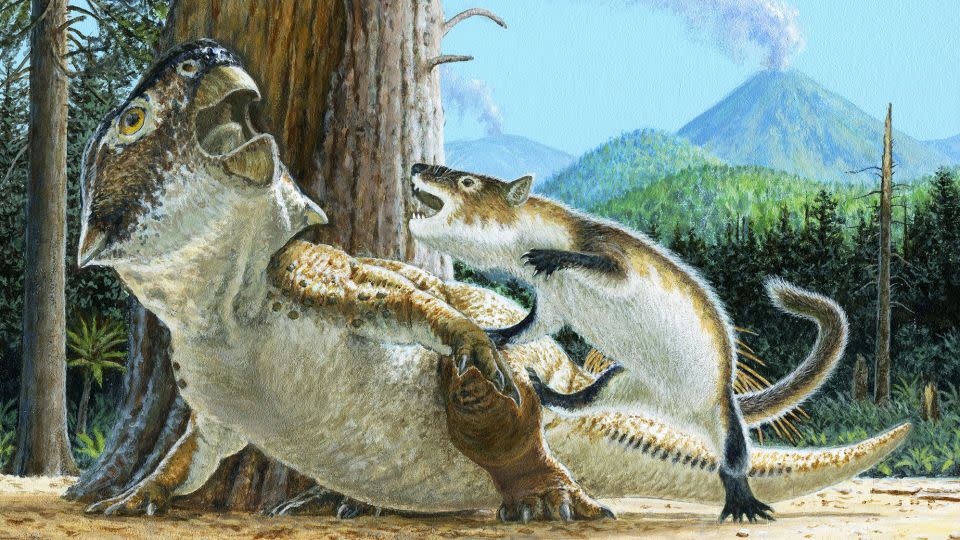‘Once in a lifetime’ fossil reveals a dinosaur and mammal locked in mortal combat
Editor’s note: Sign up for CNN’s Wonder Theory science newsletter. Explore the universe with news on fascinating discoveries, scientific advancements and more.
Sometime during the Cretaceous Period, 125 million years ago, a feisty mammal the size of a domestic cat encountered a dinosaur three times its size and thought it looked like a tasty meal.
A fossil unearthed in northeastern China captures the two creatures — a badgerlike animal called Repenomamus robustus and a species of plant-eating dinosaur known as Psittacosaurus — forever locked in mortal combat.
It’s a dramatic instant in time that challenges the idea that the earliest mammals lived in the shadows of dinosaurs, said paleobiologist Jordan Mallon, a research scientist at the Canadian Museum of Nature.

“The mammal preserved here is among the biggest mammals of the time, and you’re talking about an animal the size of a house cat. They didn’t get any bigger than that. And there was very little overlap in size between mammals, which were, you know, orders of magnitude smaller, and dinosaurs, which were an order of magnitude bigger,” said Mallon, who is coauthor of a new study that published Tuesday in the journal Scientific Reports about the striking fossil.
“The inherited wisdom has been that the ecological interactions were unilateral: The bigger dinosaurs ate the smaller mammals. And, and this upends that, it seems like these mammals could take down a bigger dinosaur if it was hungry enough or desperate enough.”
Volcanic events can yield fossil riches
The discovery is not the first evidence that early mammals preyed on dinosaurs — the remains of a Psittacosaurus were found in the stomach of R. robustus in a discovery documented in January 2005.
What makes this fossil exceptional is that the mammal is caught in the moment of attacking the almost fully grown dinosaur.
It’s extremely rare to find fossils that preserve an animal interacting with another and shed light on the predatory behavior of extinct creatures, according to Mallon.

Those examples are among the world’s most famous specimens, such as the iconic dueling dinosaurs — a fossil that shows a Triceratops horridus and a Tyrannosaurus rex in a battle for the ages.
A Psittacosaurus was a small beaked dinosaur that would have been common in the region at the time — a bit like sheep today, Mallon said. The predator and prey were almost fully grown when the attack took place.
Mallon said he “was salivating” when he got the chance to study the fossil, which was found in 2012 in China’s Liaoning province at the Lujiatun fossil beds. The site is regarded by paleontologists as a dinosaur equivalent of Pompeii. Both skeletons are nearly complete.
“This is (a) … once in a lifetime type of fossil. They just don’t come like this very often,” he explained.
Mallon said the two creatures would have died while fighting — buried together suddenly by a mudslide in the aftermath of a volcanic eruption.

Predator vs. scavenger
The fossil shows R. robustus gripping onto the lower jaw of Psittacosaurus with its left forepaw. The mammal’s left hind paw is gripping the dinosaur’s hind limb and its teeth were sunk into its prey’s ribs.
Mallon said he and his colleagues determined that the mammal was an aggressor rather than a scavenger for several reasons: There are no bite marks on the skeletons that would typically indicate scavenging, and it’s unlikely that the two animals would have been so intertwined if the mammal had happened upon a dead dinosaur.

“All these various lines of evidence pull together to suggest that this was an act of predation that was sort of snuffed out and preserved in the moment,” Mallon said.
It was impossible to know if the mammal would have emerged victorious in the encounter, according to Mallon. However, he said it was definitely “possible,” adding that in the natural world today small carnivores will successfully attack much bigger animals.
“A weasel will take down a hare that is five times its body weight, or a wolverine will take down a caribou or even a moose,” he said.
Either way, however, the two prehistoric creatures were ultimately doomed.
For more CNN news and newsletters create an account at CNN.com

